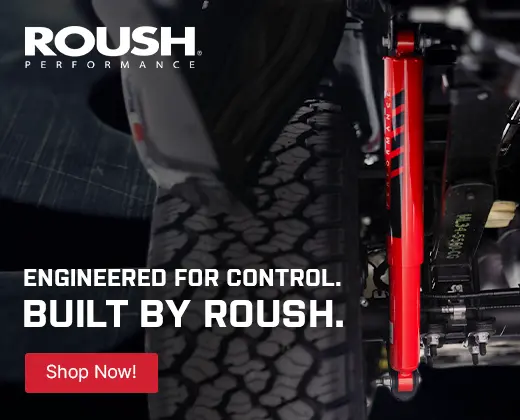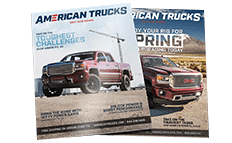Is There any Difference Between Sierra 1500 Shock Absorbers and Struts?
Shocks and struts are some of the most important components of your suspension system. Knowing the difference between the two and how different shock absorbers affect your steering and handling is crucial to customizing and maintaining your Sierra’s integrity.
For a simple definition: struts dampen coil springs, while shocks are designed to absorb impacts from leaf springs. Both components are instrumental in damping the impact that springs receive from hitting a bump.
A coil over system is similar to the standard strut/shock system, except that a lighter spring is wrapped around them. This provides a greater range of damping, which we’ll discuss later.
You may have noticed that struts are more expensive than shocks. Struts are a major structural component of your suspension system while shocks are not. Struts control handling by limiting the swey of the Sierra’s chassis frame.
Struts are surrounded by coil springs are directly responsible for the alignment of your vehicle. This is why struts are used to calibrate camber and caster angles for off-roading.
While commonly interchangeable, struts and shocks are not the same thing, nor are shocks integral to the vehicle itself. Many cars don't have rear shock absorbers, though trucks do because of their weight.
Shock absorbers damp the impact that springs take by converting kinetic energy into heat dissipation. They are single cylinder pieces that can found be found next to leaf springs in a vehicle’s suspension.
While not integral to your vehicle, they do increase the longevity of your Sierra’s springs, which can crumble under heavy impacts from huge bumps on the road.
What Advantages Do Aftermarket Shocks and Struts Provide for my Sierra 1500?
The primary function of shocks and struts are to maintain contact with your tires and the road. This makes them essential in maintaining tight steering handling.
I will say leaf spring systems are prefered by some enthusiasts because of their weight. Heavier springs offer greater contact with the ground, which is important during off-roading.
However, multi-link systems offer greater resilience when your truck does make contact with the ground, absorbing greater shocks and preventing your Sierra 1500 from bottoming out.
Beyond this, coil overs and multi-link systems offer greater customizability and naturally improved departure angles for off-roading.
Add more predictability to your ride, whether it’s off-roading or driving through slippery conditions, with adjustable, monotube coil overs. These also allow you to calibrate your valving for performance handling, which you can’t get from a stock leaf spring suspension system.
Whether you purchase a coil over kit or upgrade your OEM struts and shock absorbers, you’re sure to get improved performance from your vehicle:
- Reduced spring damping that prevents bottoming out
- Predictable handling and steering, even in rough terrain
- Optimized valving that improve the life of your pistons
They’re also required to maintain stock ride height on a lift kit.
Sierra 1500: Monotube vs. Twin-Tube Shocks
You may have heard of monotube and twin-tube shocks, both of which offer benefits of their own. Twin-tubes are reliable shocks for the casual driver, but most enthusiasts recommend a monotube shock for intense off-roading.
Monotube shocks are composed of a single hydraulic cylinder that uses high pressure gas to compress and release a piston. This process leads to dampening. The primary difference between monotube and twin tube shocks are gas pressure.
Monotube shocks separate nitrogen from hydraulic fluid to form two separate functions. The hydraulic fluid moves the piston through oil where it enters a nitrogen chamber to stabilize heat and energy being produced.
On the other hand, twin-tubes contain two hydraulic cylinders that don't separate hydraulic fluid from nitrogen. While equally effective in temperate driving conditions, this can lead to foaming when intense heat and pressure is applied to the shock absorbers.
For this reason, monotube shocks offer far greater damping; also making them far more expensive than twin-tubes. Not only does the monotube internal floating piston (IFP) design eliminate foaming and oil aeration, it allows for greater heat dissipation. Monotube shocks also provide superior customization abilities, allowing for unrestricted installation angles.
Twin-tube shocks do have some advantages of their own, such as reduced friction at the leaf spring and they’re generally cheaper. Unfortunately, twin-tubes are susceptible to foaming and have a smaller oil capacity, vastly reducing their damping ability.
Which is Better for My Sierra 1500? Non-Adjustable or Adjustable Shocks
For lift kits and off-roading, adjustable shocks allow you to customize valving and improve suspension responsiveness. With the right calibrations, adjustable shocks are designed to withstand high temperatures more effectively than non-adjustable shocks. They’re compatible with both leaf spring suspensions and dual link suspensions.
Non-adjustable stocks are pretty standard on most cars and work well with traditional leaf spring systems. They’re durable and reliable, but not nearly as responsive as adjustable shock absorbers. At a cheaper price, they’re easier to install and work well with a coil over suspension.
What are Coil Overs?
Coil overs improve upon the traditional leaf spring design by wrapping lighter springs around a standard shock absorber. Coil overs allow owners to adjust their ride height and preload to provide greater handling and predictability on the road. This comes in handy for off-roading or just driving over bumps. Mainly, they preserve your suspension system from intense shocks.
Most Sierra trucks should be compatible with a coil over suspension system, although it’s wise to consult a mechanic first. You can find coil overs in between threaded springs and just under the lower control arm of your suspension system.
Pros and Cons of Sierra 1500 Coil Overs:
Pros:
- Better handling and more predictability when turning
- Adjustable ride height and center of gravity for greater responsiveness
- Added preload
- No oil cavitation
- Minimize noise from your suspension system
- Quick and easy installation
Cons:
- Expensive
- Could wear on your struts
- Poor installation can disrupt handling
When Should I Replace My Sierra 1500 Struts
Most mechanics recommend replacing your struts every 60,000-100,000 miles. It should be pretty noticeable when your struts begin to go and cause suspension problems. Here are some easy warning signs to know if your struts need replacing.
- Excessive bouncing after going over bumps
- Hydraulic fluid leaking
- Tire wear on the inside of your tire
- Poor handling in windy or slick conditions
- Consistent bottoming out
Shop All Front & Rear Truck Shocks & Struts
Fitment Includes:
- 1999, 2000, 2001, 2002, 2003, 2004, 2005, 2006, 2007, 2008, 2009, 2010, 2011, 2012, 2013, 2014, 2015, 2016, 2017, 2018, 2019, 2020, 2021, 2022, 2023 and 2024 Sierras
- Base, C3, Classic, HT, Hybrid, Nevada Edition, SL, Z71, Denali, SLE, 1500, SLT and WT Sierras
- Engines: 4.3L Vortec V6, 4.8L Vortec V8, 5.3L Vortec V8, 5.3L Flex-Fuel Vortec V8, 5.3L Vortec V8 Hybrid, 6.0L Vortec V8, 6.2L VVT Vortec V8, 4.3L EcoTec3 V6, 5.3L EcoTec3 V8, 6.2L EcoTec3 V8 Sierras
*Please see Sierra parts pages for any exceptions.

